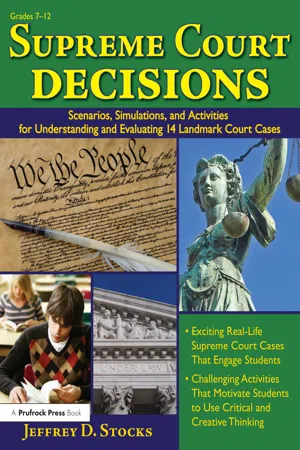
Supreme Court Decisions
Scenarios, Simulations, and Activities for Understanding and Evaluating 14 Landmark Court Cases (Grades 7-12)
- 112 pages
- English
- ePUB (mobile friendly)
- Available on iOS & Android
Supreme Court Decisions
Scenarios, Simulations, and Activities for Understanding and Evaluating 14 Landmark Court Cases (Grades 7-12)
About this book
The rich history of the U.S. Supreme Court affects everyone—so why just lecture about the landmark court decisions when you can engage students in the cases that changed the course of history? In Supreme Court Decisions, students will make predictions, use their knowledge of the Constitution, gain the perspective of people living during a historic period of time, and judge a case for themselves.
The book takes students through 14 landmark cases including Dred Scott v. Sanford, Plessy v. Ferguson, Brown v. Board of Education, Mapp v. Ohio, Miranda v. Arizona, and more. Students will find cases such as New Jersey v. T.L.O. particularly interesting because of their continuing effect on and relevance to students in school today.
Because these cases are sure to evoke different emotions and spark lively discussions among your students, the book also includes activities that will help you direct this energy into meaningful learning experiences. Your students will find the lessons in Supreme Court Decisions interesting, enjoyable, and engaging.
Grades 7-12
Frequently asked questions
- Essential is ideal for learners and professionals who enjoy exploring a wide range of subjects. Access the Essential Library with 800,000+ trusted titles and best-sellers across business, personal growth, and the humanities. Includes unlimited reading time and Standard Read Aloud voice.
- Complete: Perfect for advanced learners and researchers needing full, unrestricted access. Unlock 1.4M+ books across hundreds of subjects, including academic and specialized titles. The Complete Plan also includes advanced features like Premium Read Aloud and Research Assistant.
Please note we cannot support devices running on iOS 13 and Android 7 or earlier. Learn more about using the app.
Information
CASE 1:
THE POWER TO DESTROY
MCCULLOCH V. MARYLAND (1819)
FOR THE TEACHER
Quick Reference
Background
Discussion Questions:
- What is the major issue to be settled by the case?
- What are the facts relevant to the case?
- Why do you think the state of Maryland taxed the bank?
- How do you think the Supreme Court ruled?
- You be the judge: Should James be forced to pay the fine? Why or why not?

THE RULING
THE AFTERMATH
MAKING IT CURRENT
CASE 2:
THE STEAMBOAT CONTROVERSY
GIBBONS V. OGDEN (1824)
FOR THE TEACHER
Quick Reference
Table of contents
- Cover
- Half Title
- Title Page
- Copyright Page
- Contents
- About the Book
- Case 1: The Power to Destroy: McCulloch v. Maryland (1819)
- Case 2: The Steamboat Controversy: Gibbons v. Ogden (1824)
- Case 3: Freedom’s Suit: Dred Scott v. Sandford (1857)
- Case 4: The Confederate Sympathizer: Ex Parte Milligan (1866)
- Case 5: The Out-of-Place Passenger: Plessy v. Ferguson (1896)
- Case 6: The Instigator: Schenck v. U.S. (1919)
- Case 7: The Publisher: Gitlow v. New York (1925)
- Case 8: Into the Camp: Korematsu v. U.S. (1944)
- Case 9: The Segregated School: Brown v. Board of Education of Topeka (1954)
- Case 10: The Search: Mapp v. Ohio (1961)
- Case 11: The Indigent Defendant: Gideon v. Wainwright (1963)
- Case 12: The Confession: Miranda v. Arizona (1966)
- Case 13: The Silent Protest: Tinker v. Des Moines (1969)
- Case 14: The School Search: New Jersey v. T.L.O. (1985)
- References
- About the Author